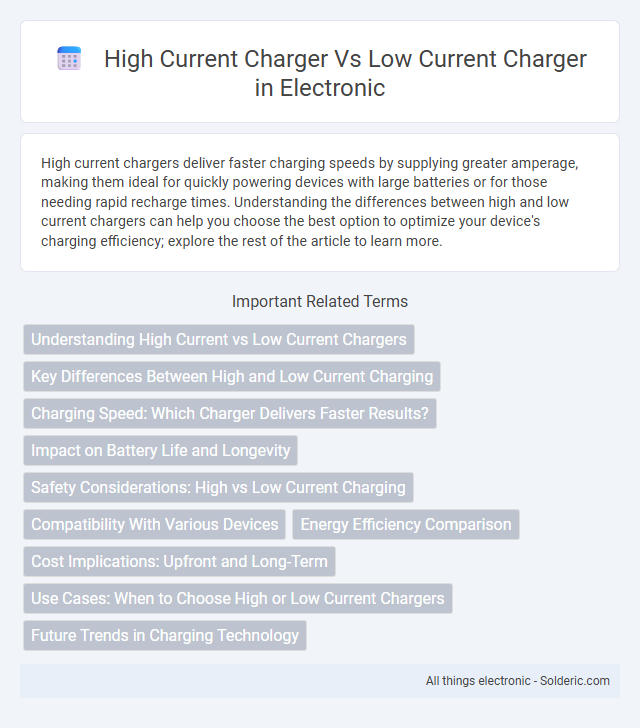High current chargers deliver faster charging speeds by supplying greater amperage, making them ideal for quickly powering devices with large batteries or for those needing rapid recharge times. Understanding the differences between high and low current chargers can help you choose the best option to optimize your device's charging efficiency; explore the rest of the article to learn more.
Comparison Table
| Feature | High Current Charger | Low Current Charger |
|---|---|---|
| Charging Speed | Fast charging; reduces charge time significantly | Slow charging; longer charge duration |
| Current Output | Typically 2A or higher | Typically below 1A |
| Device Compatibility | Best for high-capacity batteries and fast-charge supported devices | Suitable for small devices and batteries with low current limits |
| Heat Generation | Higher heat production; requires better thermal management | Lower heat generation; safer for extended charging |
| Energy Efficiency | Less efficient due to rapid charging losses | More energy-efficient with steady charging |
| Impact on Battery Life | May reduce battery lifespan if overused | Better for maintaining long-term battery health |
| Use Case | Quick charging needs, modern smartphones, tablets, laptops | Slow charging, overnight charging, smaller gadgets |
Understanding High Current vs Low Current Chargers
High current chargers deliver power rapidly, typically above 2 amps, enabling faster charging for devices such as smartphones and tablets, while low current chargers supply less than 2 amps, ideal for smaller gadgets or maintaining battery health over time. High current chargers often feature advanced technology like Quick Charge or USB Power Delivery to optimize energy transfer efficiently, whereas low current chargers are simpler and more energy-conserving, suitable for overnight charging or sensitive electronics. Choosing between high and low current chargers depends on device compatibility, desired charging speed, and battery lifespan considerations.
Key Differences Between High and Low Current Charging
High current chargers deliver significantly greater amperage, enabling faster charging for electric vehicles and devices, reducing downtime and increasing efficiency. Low current chargers provide slower, more controlled charging, which is beneficial for battery longevity and safer for sensitive electronics. The choice between high and low current charging depends on device compatibility, charging speed requirements, and battery health considerations.
Charging Speed: Which Charger Delivers Faster Results?
A high current charger delivers faster charging speed by supplying a greater amount of electrical current, significantly reducing the time required to recharge batteries compared to a low current charger. Low current chargers provide a slower, more gradual charging process, which may be more suitable for maintaining battery health but results in longer charging durations. Devices designed for high current input can fully utilize fast chargers, while others may not support or benefit from increased current levels.
Impact on Battery Life and Longevity
High current chargers deliver rapid charging by increasing the amperage, which may cause elevated heat generation and accelerate battery degradation, reducing overall battery life and longevity. Low current chargers supply a gentler charge, minimizing thermal stress and preserving the battery's chemical integrity, thus extending its lifespan. Selecting the appropriate charger current based on battery specifications is crucial for maintaining optimal battery health and maximizing its usable cycles.
Safety Considerations: High vs Low Current Charging
High current chargers deliver rapid charging but generate more heat, increasing risks of overheating, battery damage, and potential fire hazards if safety mechanisms fail. Low current chargers reduce thermal stress and extend battery lifespan by charging slowly, minimizing risks of short circuits and electrolyte degradation. Proper use of chargers with built-in protections, such as temperature monitoring and current regulation, is crucial for safe charging regardless of current level.
Compatibility With Various Devices
High current chargers deliver faster charging speeds suitable for power-hungry devices like tablets and laptops, while low current chargers are ideal for smaller gadgets such as smartphones and wearables. Compatibility with various devices depends on the charger's output specifications and the device's charging protocol. Ensuring your charger matches your device's power requirements helps maintain battery health and optimize charging efficiency.
Energy Efficiency Comparison
High current chargers typically exhibit lower energy losses during the charging process due to faster charge times, reducing overall energy consumption compared to low current chargers. Low current chargers, while gentler on battery health, often operate longer and can result in increased standby energy usage and heat dissipation. Energy efficiency metrics, such as watt-hour per charge cycle, favor high current chargers for rapid energy transfer and minimized conversion inefficiencies.
Cost Implications: Upfront and Long-Term
High current chargers typically have higher upfront costs due to advanced technology and power components, yet they reduce long-term expenses by significantly shortening charging times and enhancing battery efficiency. Low current chargers are less expensive initially but may incur higher operational costs over time due to prolonged charging durations and potential battery wear. Evaluating total cost of ownership requires balancing initial investment against energy consumption, battery lifespan, and usage frequency.
Use Cases: When to Choose High or Low Current Chargers
High current chargers are ideal for quickly charging electric vehicles, power tools, or devices with large batteries, significantly reducing downtime and enabling fast turnaround in professional or demanding environments. Low current chargers suit smaller electronics, such as smartphones or Bluetooth headsets, where slower charging preserves battery life and prevents overheating. Choosing between high and low current chargers depends on the balance between charging speed needs and battery health considerations, aligning with device specifications and usage frequency.
Future Trends in Charging Technology
High current chargers are rapidly advancing with innovations such as GaN (Gallium Nitride) technology, enabling faster charging speeds and greater energy efficiency compared to traditional low current chargers. Emerging trends highlight the integration of smart charging systems that optimize power delivery based on battery health and usage patterns, extending overall battery lifespan. Wireless and ultra-fast charging infrastructures are expected to become standard, prioritizing high current capabilities to meet the demands of electric vehicles and next-generation mobile devices.
High current charger vs low current charger Infographic

 solderic.com
solderic.com